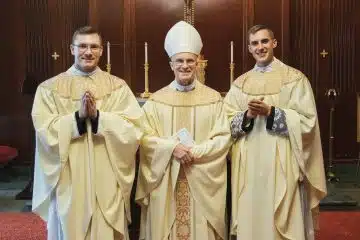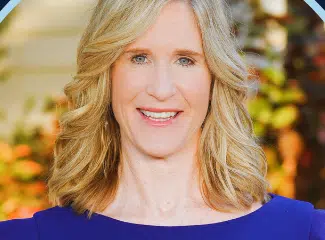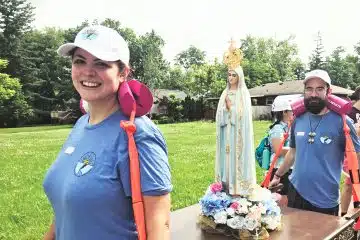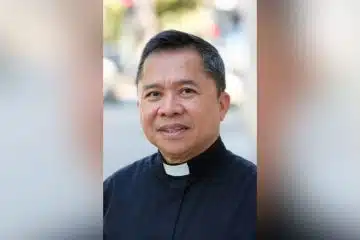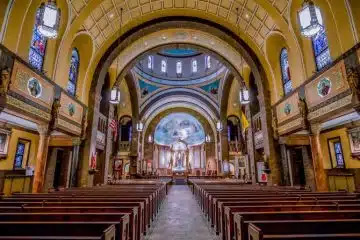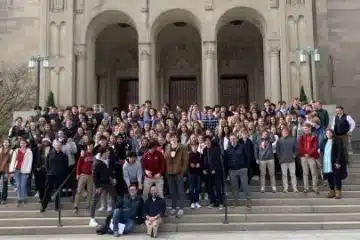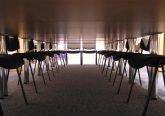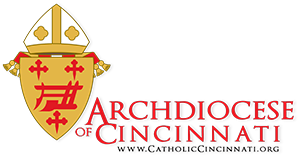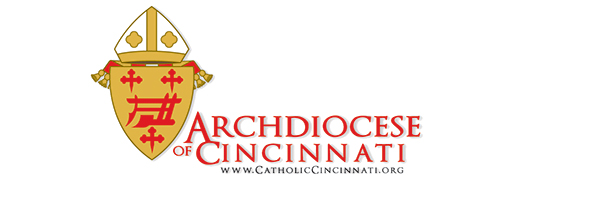APC hears presentations on permanent diaconate, CT
Wednesday, September 15, 2010
ST. FRANCIS DE SALES DEANERY — Presentations on the permanent diaconate in the Archdiocese of Cincinnati and The Catholic Telegraph filled an agenda at the Sept. 11 meeting of the Archdiocesan Pastoral Council.
Chairperson Marvin Koenig turned the morning session of the meeting, held at the Athenaeum of Ohio, over to Father Joseph Binzer, chancellor of the archdiocese, who delivered a presentation on The Catholic Telegraph. Father Binzer said he sought “wisdom, insight and input” from the APC regarding questions about the future of the archdiocesan newspaper and its frequency of delivery. Among the issues being considered, he said, was whether a monthly magazine or bi-weekly newspaper would be a more fiscally sound vehicle for archdiocesan communication.
In his hour-long presentation, Father Binzer gave a brief history of the 177-year-old newspaper and explained retired Archbishop Daniel E. Pilarczyk’s desire to use the paper as a more widely circulated vehicle for adult faith formation in the late 1990s. At the height of circulation in the early 2000s, the paper reached 102,000 of about 180,000 households. Financial concerns in many parishes have dropped that circulation to a little over 50,000 households receiving the newspaper out of 150,000.
APC members were also given a copy of a survey about the paper sent in 2009 to priests in the archdiocese. More than 100 priests, “a good cross-section,” Father Binzer noted, responded to the survey, which made it clear that the reading habits of priests are very wide and varied. “There were probably 25-50 websites identified that priests look at, but for the most part, priests don’t go to the internet; they read more printed materials,” Father Binzer said.
As of Sept. 1, 2010, only about 52 parishes in the archdiocese are adhering to the mandate that 50 percent of registered households receive the newspaper.
“In speaking with Archbishop Schnurr, it’s clear that having information about the diocese in the hands of people is very important,” Father Binzer said.
But proposed increases in postage rates and unpaid parish subscription bills put the future of the newspaper in some doubt. Subscription costs have not been raised in a decade, but “to increase subscription costs might cause even more parishes to opt out,” he said.
Among the options that have been discussed is replacing the newspaper with the four-color Faith magazine, a national publication that is published 12 times a year and offers 2-3 pages for local news in each issue. Decreasing the frequency of the current newspaper is another possibility. Some dioceses, such as San Diego, offer only online publications at this time in their history.
Father Binzer also outlined the cost-cutting measures that have been in effect over the years. The newspaper comes close to breaking even in terms of printing and postage costs, but advertising and circulation revenues do not currently cover salaries and equipment.
Father Christopher Armstrong, pastor of St. Antoninus Parish in Cincinnati, said that as a pastor he believes it is important to “foster communication.” His parish uses The Catholic Telegraph for faith formation, and he said he refers to the paper from time to time while preaching. At times parishioners will ask him if he’s seen particular stories, so he believes his efforts have been effective.
“I personally think the CT as a means of adult faith formation is very important to the faith life of the archdiocese,” he said.
APC members suggested a variety of things to examine: making the newspaper part of a media studies effort, particularly among young people; tying the newspaper to the Catholic Ministries Appeal as a gift for donors; and the use of “blended means” of delivering the news, using hard copy and electronic delivery in a complementary manner. The majority of those present seemed to feel a bi-weekly delivery of the newspaper would be sufficient.
Chip Williamson, who is involved in youth ministry, said the issue seems to be two-fold: “The content of the paper, which I think is on target, and the connectedness of the whole church, but it’s the delivery mechanism that seems to be where all the fits are. It’s costly to put something in someone’s hands these days. The internet is a way of connecting to people. People are spending more time at their email box than at their mail box.”
Father Binzer said that the paper “is at a crossroads. I don’t think the mission has changed much in the years since Bishop Fenwick founded it. Where we are is trying to come up with some new balance on how we report news with faith formation.”
Archbishop Schnurr spoke about the frustrations he experienced in Duluth with a publication that was delivered five times a year to households. “There was no way for a bishop to speak to his people. I initiated a newspaper that came out once a month, and it was amazing how much more quickly much of the diocese came together; it had been very segmented. Putting the newspaper out once a month worked very well. But we definitely need some publication in the diocese, I believe. Bishop Fenwick wanted to be certain Catholics got the real story. I think that need exists today. It should be the place where Catholics can go with confidence to know they are getting the real story. It also has to have that faith formation component.”
He noted that his experience on the communications committee of the USCCB has shown him that the number of Catholic newspaper subscriptions all over the country is dropping.
“The mode of delivering news is changing. We have to find a new delivery system,” the archbishop said.
In an afternoon presentation, Barry Mersmann, director of the archdiocesan Permanent Diaconate Office, and Deacon George Bruce and his wife, Donna, updated the APC on the ministry of permanent deacons.
Currently there are 202 deacons in the archdiocese, a number that has “doubled over the last 12 years,” Mersmann said, “and 179 serve actively in parishes. Fifty-four percent of parishes have at least one deacon.”
He outlined for the group the training and education a man must undergo, the academic requirements for the permanent diaconate, as well as the personal and spiritual characteristics that are generally needed. The diaconate is a vocation, not a hobby or something to take up in retirement, he emphasized.
Thirty-three men have been ordained in the last two classes of permanent deacons, and the next class will be about 25, Mersmann said. “I have a lot of interest from a lot of men. All of us are called to the diaconate by baptism; but some want to continue it to another level,” that of ordination.
The Bruces spoke eloquently about their experience; Deacon Bruce was ordained in 1998, one of a class of 21 men. He has seen an evolution in his role at St. William Parish in Cincinnati in the last 12 years.
“It has been a blessing,” he said. “One of the important roles of the deacon is being out there in the world — one foot in the church, one foot in the world. People have often come to me if they had a particular beef with the church or there was something they didn’t understand.”
Deacon Bruce retired as an optician and now works as a pastoral associate at his parish. He noted he could not have been involved in his ministry without his wife’s support.
“I know I am a big help to our pastor, sacramentally and being in charge of RCIA, adult faith formation, as a procurator presenting marriage cases for the Tribunal. Many parishioners may feel more at ease coming to me if they have a problem.”
But “we’re not mini-priests, and I think people see that,” he added.
Donna Bruce offered a down-to-earth and humorous viewpoint on being married to a clergyman. “This is his ministry; my role is to support him and help him achieve what God has in His mind for him.”
She said that she has received many blessings as a result of her role, finding that people in the workplace often wish to confide in her, ask her questions or discuss issues.
“I’ve had so many opportunities . . . just because of that knowledge that I’m involved and married to a deacon,” she said. “Watching him grow and evolve is such a blessing for our family.”
APC members asked questions about spiritual growth, about preaching faculties and about ways in which to place deacons in parishes that currently have none, rather than having five at one parish.
“If a parish is looking for a deacon, I will advertise it to the deacon community,” Mersmann said. “More often than not, someone will come forward.”
In the open forum, several departing APC members expressed their gratitude for their experience on the commission that advises the archbishop.
In his remarks, Archbishop Schnurr outlined some of his activities in recent months and said he enjoys visiting parishes and schools very much: “It’s a good way to get to know the diocese. Young people don’t like being labeled the ‘church of the future’ as if they’re on the shelf,” he said. “If I don’t get into the schools, that reinforces that they’re not important now.”
He told the APC members about the new superintendent of Catholic schools, Dr. Jim Rigg: “We found the right person. He brings a lot of enthusiasm to the work,” and noted that the archdiocese is also fortunate to have a new Family Life Office director, Colleen Gerke.
The archbishop also updated the commission on the numbers of men studying for the priesthood in pre-seminary programs in Columbus and Indianapolis and in seminary in Cincinnati. Thirty-four men are currently enrolled at Mount St. Mary’s, but “I still have more ideas as to what we could be doing to promote culture of vocations in archdiocese,” he said.
He also spoke of a recent experience at Fatima USA at Maria Stein in August.
“I was very impressed by the event, which drew about 1,500 people, all age groups,” Archbishop Schnurr said, calling it “a really inspiring evening.”
He thanked the departing APC members for their service and noted that the meetings are a good exhange of ideas. Just as his predecessor appreciated honesty, he does as well, he said. “I want people to be as candid as possible. There’s no sense in having a meeting if we’re not going to say what’s on our mind.”


